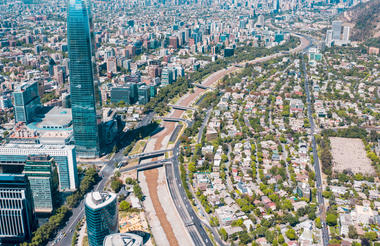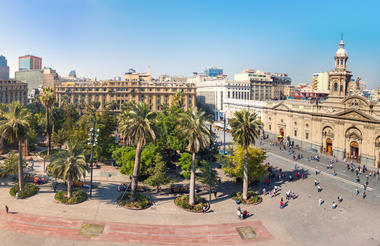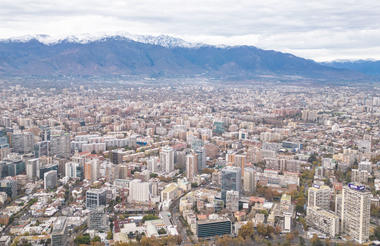Surrounded by the peaks of the Andean Plateau and overlooked by the 6402m Mt. Illimani, La Paz is a truly breathtaking city whose buildings sprawl across the surrounding canyon, reaching altitudes of up to 4100m. While the sight of the city is reason enough to visit, La Paz holds a number of attractions sure to keep tourists fascinated. Take a walk along Calle Jaen, a colonial street lined with museums, explore the city's cathedrals or wander through some of the colourful markets, including the 'Witches' Market' where llama foetuses and dried frogs can be found for sale.



On the shore of Lake Titicaca lies the original Copacabana. For centuries, this small Bolivian town has been a sacred destination, with pilgrims flocking to visit the famed Camarin de la Virgen de Candelaria, a statue considered to have miraculous powers. Visitors to the town can see the renowned figure in one of the oldest churches in the country and take in stunning views on the Cerro Calvario hill, a climb which includes Stations of the Cross often frequented by the faithful. The town has numerous festivals where local Aymara women take to the streets, dancing in their traditional colourful dresses and bowler hats.



The largest island on Lake Titicaca, the “Island in the Sun” is an ancient holy Inca site with over 80 ruins dating back to the 15th century AD. The rocky piece of land can only be explored by foot and there are several walking tracks to help visitors get around. Among the Inca monuments, tourists will find the Inca Table, a platform thought to have been used for human sacrifices; the remains of a two-story palace; and a set of rock impressions dubbed The Footsteps of the Sun. The island also boasts an Inca gold museum and a spring that the Spaniards thought to be the fountain of youth.



As previously described



Chuvica is a small settlement in Bolivia, set on the southern edge of the Uyuni Salt Flats, the largest salt lake on earth. This little town serves as a base for tours and expeditions of the extraordinary natural area, which also boasts spectacular rugged hills strewn with desert vegetation, making it an ideal destination for photographers and outdoor enthusiasts. The salt lake, often nicknamed ‘the largest mirror in the world’, offers an unusual and phenomenal experience up close with nature. Spreading over more than 10,000 square kilometres, backed by striking mountains, and decorated by exquisite patterns made by the salt, this is one of the country’s top must-see attractions. Set between Bolivia, Chile, and Argentina, this location is also ideal for travellers wishing to explore the fascinating neighbouring countries.



Villamar Mallcu is located in the remote vast plains of Southwestern Bolivia, on the northwestern edge of the Cordillera de Lipez. The striking landscapes are characterised by strange volcanic rock formations, bubbling turquoise hot springs and multi-coloured sands, and are home to ancient rock paintings (Pinturas Rupestres). The small town boasts a vibrant craft market selling an incredible collection of finely made artisanal crafts. The Andina Eduardo Avaroa National Fauna Reserve is a short drive away, offering the chance to see flocks of pink flamingos, herds of vicuna grazing the Altiplano, 80 species of birds, as well as the shy viscachas and Andean foxes.
The small town of San Pedro de Atacama is a scenic oasis in the Atacama Desert, surrounded by the imposing volcanic peaks of the Chilean altiplano and located close to several major archaeological and natural attractions. The fascinating ancient sites of Tulor and Quitor, the enthralling Atacama Salt Flat, the jaw-dropping turquoise Altiplanic Lagoons, and the other-worldly Tatio Geysers all lie nearby, and as a result, the village has become a significant tourist destination. Despite its small size it encompasses a wide range of restaurants; however, it is also known for its ‘western feel’ and retains an old-world charm. History enthusiasts will enjoy a visit to the atmospheric 17th-century Iglesia San Pedro. However, it is really the breathtaking surroundings that make this destination special.
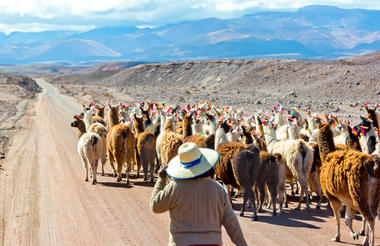
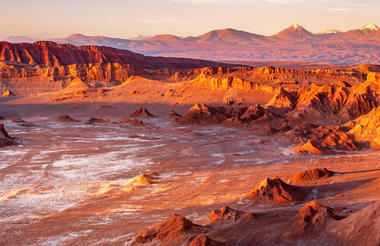
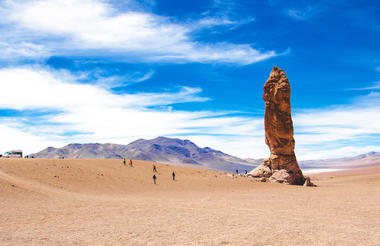
An enticing mix of historical architecture, picturesque views and sprawling vineyards await travellers to Salta, located in the lovely Lerma Valley in the Andean foothills. Simply wandering through the streets of the central city area will take you past a variety of impressive 18th and 19th-century buildings, including the neoclassical Cathedral of Salta, the ornate Church of Saint Francis and the Museum of High Mountain Archaeology – housing a collection of ancient Inca relics. Other popular attractions are the area’s array of exceptional wineries, and the panoramic views over the region visitors from the top of San Bernado Hill.



Cafayate is jaw droppingly beautiful. Vibrant rows of grapevines contrast against the stark ridges and undulating mountain scenery, making travelling to the northern echelons of Argentina well worth it, and this small town attracts wine enthusiasts and naturalists alike. Don’t miss out on the striking geological folds of the Cafayate Amphitheatre or hiking the six-kilometre trail that follows the Colorado River. Wine-loving visitors will be rewarded with lip smacking Torrontes wine, an Argentinean white varietal that can be found in many of the cool bodegas (cellars) around town, while those arriving by road from Salta will enjoy the spectacular views along the scenic National Route 68.



Resting in the foothills of Argentina’s Andes Mountain Range, Mendoza has a rich gastronomic heritage, and produces some of Argentina’s most exceptional wines and olive oil. Gourmands can participate in tours and tastings at the many wineries and sample delicious local cuisine at the laid-back cafes. The city also boasts a number of historic attractions, most notably the Museo Fundacional which displays the town’s progress through human evolution, and the Museo Historico General San Martin which honours Jose de San Martin, the general who liberated Argentina from the Spanish. Other highlights include: charming, well-kept parks; bustling, fountain-adorned plazas; and the opportunity for picturesque hiking, skiing and rafting in the nearby Andes. Several exquisite churches and art-deco architecture add to the town’s landscape.



The name Mendoza is synonymous with wine. Surrounded by breathtakingly beautiful Andean scenery, the Mendoza Wine Region is known for its vast vineyards, a wide variety of exceptional wines, and spectacularly majestic scenery. The landscape features desert terrain and mountain vistas interspersed with lush Visitors can look forward to sampling the regions vast selection of world-famous, award-winning vintages including a variety of malbecs at an endless array of fantastic wineries. Other popular activities include: white-water rafting, rock-climbing, skiing, horse riding and other adventures in the nearby Andes. Don’t miss the opportunity to hike several magnificent peaks on the Cordon del Plata reaching over 6000 metres above sea level and take on the highest peak in the Americas, Mt Aconcagua.



Resting in the foothills of the Andes in western Argentina, Potrerillos is a district of the Luján de Cuyo Department in the province of Mendoza. The district features some exceptional natural scenery and serves as a popular eco-tourism destination with a range of outdoor activities on offer including canoeing, hiking, fishing, white-water rafting, windsurfing, kayaking, and camping. The lovely Mendoza River meanders past the eastern edge of the town of Potrerillos and discharges into the exquisite trout-filled Potrerillos Dam. The banks of this dam and river are fringed by an array of cabins and inns, providing a peaceful retreat away from the city of Mendoza which lies only 60 km to the south. Must-see sights of the surrounding area include: the small but charming Vallecitos ski resort and the healing hot spring waters of Cacheuta.



Los Penitentes lies in west-central Argentina near the Chilean border. This resort, about 180 kilometres from Mendoza, offers outdoor lovers some wonderful activities and natural sights. Ski season (July and August) at Los Penitentes provides visitors with a range of amenities, from a ski school to learn the basics to a Snow Garden where children can be minded while their parents hit the slopes and a range of accommodation options and restaurants. Meanwhile, in summer (December to March) visitors can take the lift up to the peaks for walking, and active travellers should head to Aconcagua Provincial Park for trekking and climbing, as well as to view Aconcagua (the highest peak in the Andes) – though note that permits are required. Finally, be sure to make reservations as the resort fills up quickly over peak season.



Resting in a valley surrounded by the snow-capped Andes and the Chilean Coast Range, Chile’s vibrant, cosmopolitan, the capital city of Santiago is famous for its beautiful parks, a wealth of historical attractions, and exciting arts and music scenes. The Cerro San Cristobal Park, the largest green space in the city, lies on a hill and is reached by a funicular ride. It offers visitors stunning sweeping views of the city, as well as a picturesque botanical garden and two huge swimming pools. The colonial Plaza de Armas, in the old town centre, is a delight to explore with its numerous Neoclassical buildings and museums, most notably the home-turned-museum of renowned poet Pablo Neruda. Visitors can also look forward to wonderful live shows, concerts and exhibitions.
